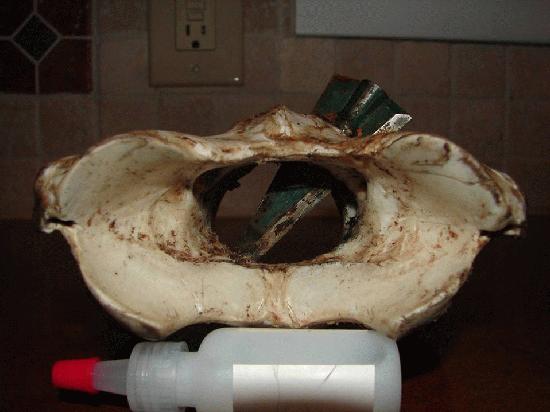Home › Forums › Bows and Equipment › Stories, Experience and your Dr. Ashby Inspired Set-Up
-
AuthorPosts
-
-
I was wondering if anyone out there has some pictures or stories to share about there experience(s) in the field with any and all types of broadheads, namely single bevels. I have tailored my set-up this year to Dr. Ashby’s recommendations but have yet to harvest a game animal with a single bevel head. I am wishing away summer as fast as I can! I am shooting a Black Widow PMA III pulling 49 lbs at my 28 inch draw. My arrows are Easton Axis N-Fused carbons with 100 grain brass inserts tipped with 217 grain (w/ adapter) Abowyer Brown Bear broadheads. I used the FOC calculation chart in the Ashby Library and my arrows are 24.38% EFoC. What is everyone else shooting this year? I thank you all in advance…
-
This is the section I’m looking forward to the most! I’m really interested in the experiences other have when applying the Study’s data to their arrow selection. To start things off, I’ll pass along just a few of the photos that folks have sent me.
This first one is David Messiaen’s Spanish Apls Mouflon, taken in 2008.
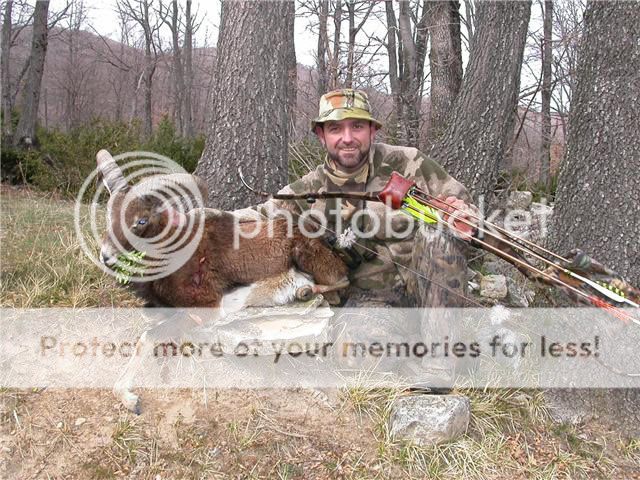
Here’s the entrance side scapula of David’s Mouflon, showing the true ‘hole’ left by the single-bevel Grizzly.
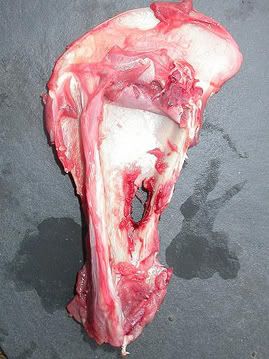
And the exit side scapula of David’s Mouflon, split near the head.
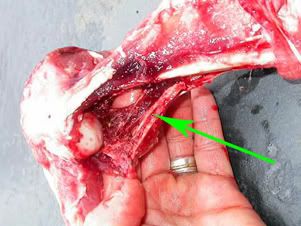
Here’s Benji Hill’s 2008 Elk.
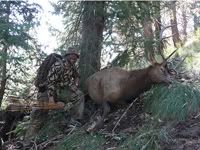
These are the holes left by the passage of the single-bevel grizzly as it passed through the elk’s lungs. Note size of the holes in comparison to Benji’s hands. This is the ‘scrambling’ or ‘mushing’ effect (so named by Ray Hammond) of the rotating single-bevel BH through soft tissues.

Here’s are close-ups of the mushed up lung tissues.
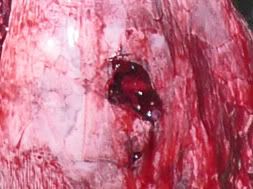
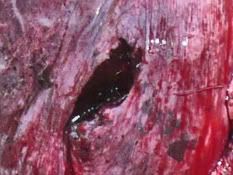
Next are the 2 sides of a whitetail pelvic girdle hit; from Wesley Mulkey. Note size of the holes through the bone and the amount of clearance the single-beveled BH on his EFOC arrow created for the trailing shaft!
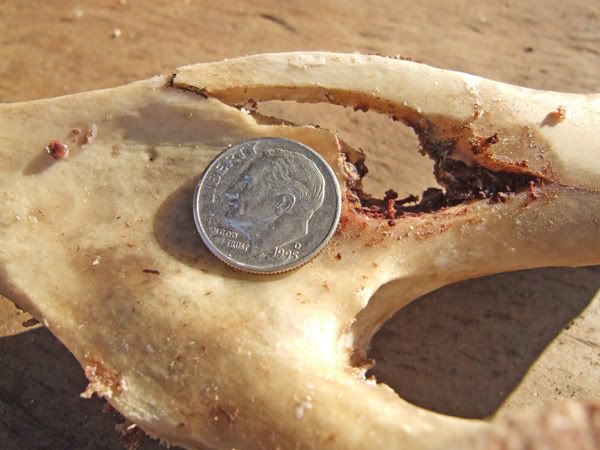

Also from Wesley Mulkey, a completely blow-apart ball joint on the entrance side shoulder on a whitetail; with the head of the scapula being severed on the off side.

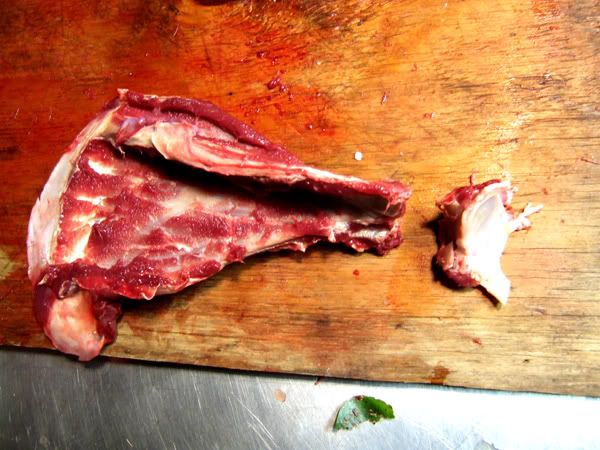
Ed
-
Those are some very convincing pictures Dr. Ashby! Do you happen to know any of the stats regarding the set-ups i.e. draw weight, EFoC, arrow material, yardage, etc. Thank you again for the great pictures!!
-
IronCreekArcher wrote: Those are some very convincing pictures Dr. Ashby! Do you happen to know any of the stats regarding the set-ups i.e. draw weight, EFoC, arrow material, yardage, etc. Thank you again for the great pictures!!
Here’s what info I have on these particular shots:
All I know on Benji’s elk is that he used the 160 gr. Grizzly BH on a heavy shaft.
English is a second language for David, but here’s what I can ascertain for certain from his letter: Re his Spanish Alps Mouflon. David used a 55#@28″ draw recurve. All I could get on the arrow was that it was a “heavy arrow” with a 190 gr. Grizzly. David did the stalk by crawling on his belly. With the mouflon downhill at 11 yards, David raised to his knees. From there he says he could only get a partial draw (he indicates about a 1/2 draw), with his bow held horizontal, before the string hit his chest. At the shot, to quote David “The heavy arrow and Grizzly broadhead disappeared from sight”. The shaft was a through and through, and the mouflon dropped almost immediately; with the bone-hit results shown in the photos above.
I have much more arrow detail on Wesley’s shots. The bow was a 70# Compound. The arrows weigh 654 grains. They have the 190 gr. Grizzly and are 26% FOC. Both the pelvic gurdle shot and the shoulder shot were pass-throughs.
It’s interesting that some folks say whitetails are so easy to penetrate that it matters little what arrow setup one uses. Wesley is an exceptional shot; a former Georgia State 3-D Champion; and a highly experienced bowhunter. What led him to experiment with the Study-suggested arrow setup, and then change his setup to the arrow described above (which is now his “one and only” hunting arrow setup), was a series of unintended hits, by both himself (with this same 70# compound) and Harold (Wesley’s father – also using a compound, but I don’t know the draw weight), into the ‘heavy bones’ on Georgia whitetails that resulted in unrecovered animals. The recovered arrows showed damaged arrows/broadheads and scant penetration, suggestive of a failure to penetrate the bone, or bones.
Ed
-
I posted this case study as a seperate thread, but it rightly belongs here.
Here’s an example of how and why all the information we can assemble, regardless of the equipment used, helps expand our understanding of how arrow design affects arrow terminal performance; which is the entire purpose of this forum.
If you will check out the “CSI – Mozambique Penetration Test” on the Bowsite forum site (http://www.bowsite.com/bowsite/features/articles/equipment/penetration2/) there is some very useful information, and I highly commend Mr. Pat Lefemine for collecting and posting the data from his Cape buffalo kill shot and three test shots. I do wish the skin had not been removed from the buffalo before the test shots were taken, but as Mr. Lefemine correctly states in the associated discussion thread, the skin of the Cape buffalo (over the chest area) is not very thick, and its absence probably had little effect on the results. Having hunted and tested on both Cape and Asian buffalo, the structural differences between the Cape and Asian (as noted in the 2004 Study Updates) is what makes the Asian buffalo somewhat more difficult to penetrate than the Cape buffalo, with skin thickness over the chest area being one of the very notable differences.
Please check out the results of the Cape buffalo shots shown on Bowsite. The bow used is a 90# compound, the arrow is an 1100 grain double-shafted one, and the broadhead a double-beveled, 200 grain Muzzy single blade. The reported velocity is 200 fps. That translates to 97.7 ft.-lbs. of kinetic energy (KE) and 0.977 Slug-Feet/Second of momentum.
These results make an excellent comparison base against the best performing, penetration maximized arrow setup tested in the Study, to date. That would be the Internally Footed EFOC arrow, as detailed in 2007 Update, Part 3. The bow used was an 82# at 27” draw, straight-end longbow. Arrow weight is 790 grains, only 2/3 the mass of the compound’s arrow. Velocity was a modest 151 fps, 25 % slower than the compounds arrow. This gives 38.9 ft.-lbs. of KE, less than 40% of the KE carried by the compound’s 1100 grain arrow. It has a momentum of 0.523 Slug-Feet/Second, just over one-half that of the compound’s heavier arrow.
On a very large adult Asian buffalo (not skinned), on all back of the shoulder shots, from a test distance of 20 yards, these 790 grain, penetration-maximized arrows broke both the entrance and exit side ribs on each hit, with 100% of the shots (5 of 5) providing an exit wound through the 1” thick skin. Median tissue penetration (the length of the wound channel through the tissues, not counting off-side arrow protrusion) was 23.875 inches. On its one shoulder shot it broke ribs on both the entrance and exit sides, with the broadhead passing completely through the off side rib, but failed to exit the skin.
This same bow and penetration-maximized arrow setup also produced an exit wound on a hunted trophy class bull, sticking some 20” of shaft out the off-side. All of these shots exceed the penetration shown/described by any of the compound’s reported Cape buffalo shots. We can’t directly compare scapular hits, because of the shooting angle differences. The only scapula shots taken in the Study’s testing were taken at 45 degrees, quartering from the front. As noted in the Update, that shooting angle was used because this particular test sequence was primarily directed at the structural integrity aspect of the Internal Footing, not at penetrating the scapula. However, even from this extremely adverse shooting angle one-half (3 of 6) of those shots penetrated the scapula, with two stopping in the on-side rib and one penetrating the underlying rib, entering the lungs.
What accounts for the terminal performance difference, despite the compound’s huge advantage in arrow force? It’s all about getting the maximum amount of ‘useful work’ out of whatever force your arrow carries, and squandering as little as possible on ‘non-productive’ work. This is achieved by assembling the best possible combination of penetration-enhancing factors.
Assuming that arrow flight is equally well-tuned for the arrows used in both test sequences discussed here, but not having all the dimensions before me for Mr. Lefemine’s arrow setup I can’t compare some features, such as any possible ferrule-diameter/shaft-diameter ratio differences. However, some arrow features can be logically compared.
I don’t have the mechanical advantage (MA) for the broadhead used in the Mozambique testing, but the photos are available to examine. There’s little doubt the MA of the Muzzy 2 blade broadhead used is less than 1/2 that of the Modified Grizzly’s. There’s also a marked difference in the ferrule taper and fade-in between the Muzzy and that of the Grizzly, with a clear advantage in both ferrule MA and ‘smoothness’ going to the Grizzly. The FOC difference would be a big force-saving advantage for the Study’s penetration-enhanced arrow, both at impact and once the bone(s) was breached. The Modified Grizzly’s single-bevel bone-splitting advantage would also have conserved a substantial amount of the available arrow force in breaching the heavy bones.
Remember that each force-saving penetration factor is compounded by each of the other force saving factors; and the same is true for each force-squandering factor. The outcome arrow penetration is not a sum of the improvement yielded by each of the penetration enhancing factors, it is the product of them. Each factor’s influence on the arrow’s penetration, whether good or bad, must be multiplied by the influence of each of the other factors.
The larger the game you hunt, or the lighter the poundage of the bow you use, the more important it becomes to maximize your arrow’s potential. The outcomes from these comparable tests are a dramatic example of the potential gains that you can obtain in terminal arrow performance, merely by maximizing the penetration potential of your arrow. Within reason, it is rarely the bow used that determines the outcome. Once it is launched, it’s all about the arrow.
Ed
-
That is some great info Dr. Ashby!
-
G’day All,
I received an email from Dave Peterson asking me to detail my recent experience using a single bevel Grizzly broadhead to harvest a New Zealand wild boar.I used to hunt with a compound but had been shooting a cheap 55lb Samick longbow at bowhunting tournaments for a couple of years and I felt like it was time to actually take the bent stick hunting. My first encounter using the longbow was with a mob of feral goats. I was using alloy arrows (don’t ask me what type because I can’t remember) with an Australian made double bevel 125gr broadhead. Not to go into too much detail, I was presented with a quartering on shot at about 12 yards on a reasonable sized billy. Not the best situation, I admit, but goats aren’t a particularly heavy boned animal, or so I thought. The shot was accurate and the goat gave a bit of a squark and disappeared down into a dark gully. I went to find the blood trail, but to my dismay, I found my arrow with a bent broadhead and a small scallop of flesh, the billy would live to see another day and have a cool scar to show off to all the nannies. I began to have serious doubts about my set-up, if I could not get an arrow to mortally wound a goat, how would I fare against my primary prey, wild boar with their large shield? I put the longbow away for a couple of years and only brought it out for tournaments.
In the years that followed, I changed to Port Orford Cedar shafts, primarily because wooden shafts were mandatory for tournaments, also because they were more forgiving and tended to survive the odd stray shot without bending like alloys. Again my desire to hunt with a longbow returned, but with a mortgage and the arrival of my son, I didn’t have sufficient funds to upgrade to a heavier poundage bow. So I began to do a little research and I found Dr Ed’s penetration test results, and “Why Single Bevel Broadheads?” article. I ground the double bevel off one of the Australian broadheads I had left over and re-sharpened it with a single bevel and carried out the ‘potato test’. I was convinced. With next trip to my archery shop, I purchased a set of 145gr Grizzlies and followed the sharpening instructions specified in the article “Grizzly Broadheads – and the tanto point” by C.Lacey.
The next day I was up in the New Zealand bush stalking in on a mob of goats, when I caught some movement in the corner of my eye. A wild boar emerged from the scrub. I was caught in the open with no cover at all. I froze. The boar wandered towards me. Its head dropped and it began rooting up a clump of fern, seizing my chance I quickly nocked an arrow. The boar finished its snack, and ambled to within 11 yards of where I was standing. It sudden became aware that something was wrong, and began to slowly turn, exposing its right flank as it did this I slowly drew back on the bow focusing on a small spot behind its front leg. As soon as I hit my anchor, I released and the arrow embedded itself tight in behind the front leg. I followed a strong blood trail (stronger than some I have followed from a three bladed Muzzy of my compound) and I found the boar thirty yards away. Unfortunately, I had not brought a decent camera with me (damn Murphy’s law!!). There was an ‘L’ shaped entry wound and while gutting the boar, when I cut into the chest cavity, the remnants of right lung literally fell out in little pieces and the left lung had a serious hole in it, I had just missed the heart. The broadhead had passed through the shield, both sets of ribs and was still embedded in the left shoulder. It took me 5 hours to carry it back to the car, and it went 115lbs.
A rifle hunting friend gave me a hand butchering the boar. He gave me a puzzled look when he examined the wound path and asked whether I had actually shot it with a rifle due to the damage which he compared to the damage a .223 rifle would do. As we removed and boned out the left shoulder, I removed the broadhead to prove that it was actually bow-shot and we found that the left leg was actually broken, I cannot speculate on whether this was caused by the broadhead or by the boar rolling down the hill in its death throes.
I’m certainly sold on single bevel broadheads. I believe shot placement played a part in the actual penetration of the arrow, but the severe damage and significant blood trail was all down to the broadhead.
Sean Moynihan
Editor – New Zealand Bowhunters Society Magazine. -
Thank you for sharing, there is some valuable information there.
-
I finally have this year’s deer/elk setup tested and ready to go hunting: 28.5″ Carbon Extreme shafts with standard 3-fletch, 100-grain brass inserts, 100-grain steel adapters, 175-grain Abowyer Brown Bear heads, netting an overall weight of 680 grains with a whopping 26+ percent FoC. And they fly really well. I haven’t felt this confident in my arrow setup, and thus in my shooting, in years. I will continue to experiment with other setups, and will carry other heads to shoot into freshly killed elk scapulas as discussed elsewhere, but this setup is pretty set in stone at this point. I’ve also built target and blunt arrows to match. As mentioned in another post/thread, I’ve consistently gotten better penetration in foam with this combo than I have with arrows weighing 70 grains more but slightly less FoC. It’s all good fun, good practice, and educational. dave
-
Sounds like a heck of a set-up Dave. Ol’ Wapiti better watchout! I too have been getting great penetration in foam with my 24% EFoC arrows. Needless to say I am very excited for the upcoming fall. The only thing I am worried about is the aluminium broadhead adapters. I wish I would have tuned for steel but it’s a little too late now. I am hoping whitetails won’t cause to much havoc with them…we’ll see I guess.
-
IronCreek — According to the Doc, most insert failures occur with angled impacts to bone. Take only pure broadside shots you should be cool. s
-
IronCreek,
What are the details on your arrow set-up? Are you shooting carbon, wood or aluminum? I’m curious to know, if you don’t mind.
Michael
-
Michael,
I am shooting Easton Axis 500 N-Fused Carbon arrows with a 100 grain brass insert, around 40 grain aluminum broadhead adapter and 175 grain Abowyer Brown Bear broadhead. My total arrow weight is 550 grains from a 49 lb Black Widow Recurve.
-
Iron — It would be an interesting and likely worthwhile experiment to exchange one alum insert for a 100-grain brass and see how she flies. If the spine holds which it likely will unless already maxed-out, you’ll pick up more FoC and penetration yet, and reduce chance of insert failure. I don’t know about you, but endless set-up experimentation is part of the pre-hunt fun for me. Dave 🙂
-
This is a boar I shot this year in his bed @ 9 yards, with a 60lb Centaur 650 grain total arrow weight with a el grandy, this is the path of the arrow.

the arrow went through the ridge breaking it off and going through the scapula, in effect 2 bones.


It went down into the lung severing the right lobe completely off.:shock:

-
This is a buck I shot @ 5 yards, 55lb Habu recurve 550 total grain arrow with a 160 Grizzly.
This arrow did not go through the thin part of the scapula, it is at least 1/2 thick.
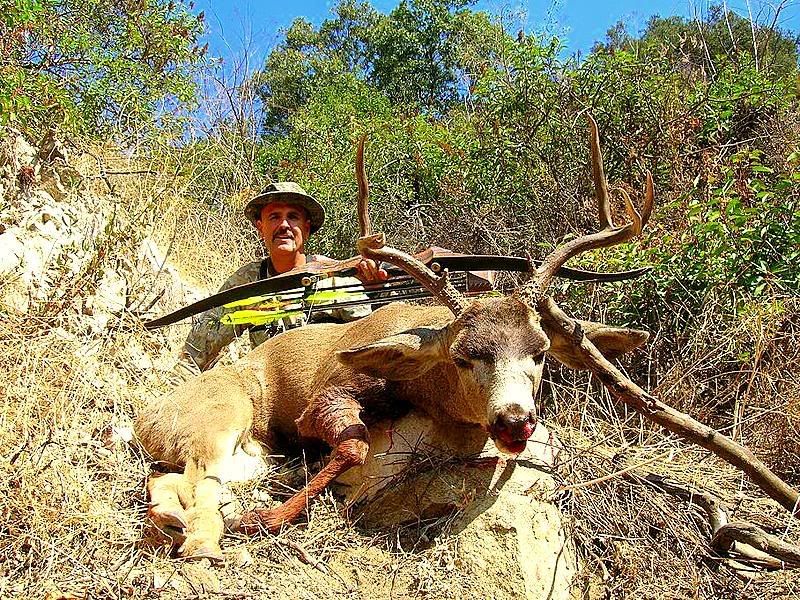
This is his left scapula and the arrow went in about 10″, no exit though, I have worked up an arrow that should crash through both shoulder blades now.
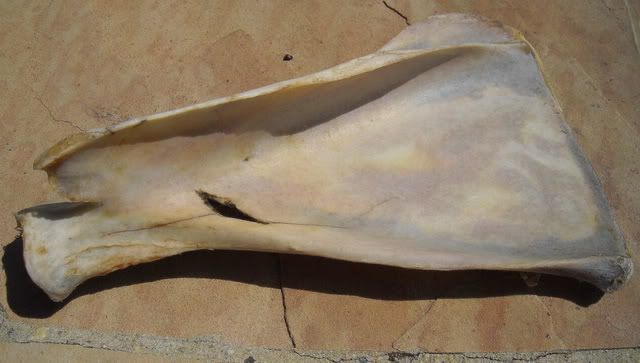
This is the exit side or what you could call the inside of the scapula, you can clearly see the “S” in the bone split.
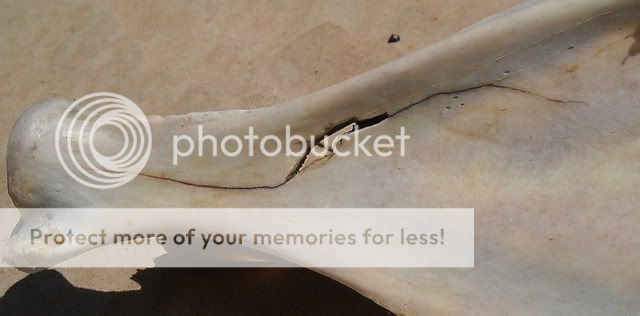
-
Thank you, King, for these great photos that speak for themselves about the gear you’ve chosen to use, and why. From the number of animals you’ve killed with single-bevels, apparently you got onto this magic a long time ago! Keep it coming, please. Snuffs
-
KING!! Great to see you again!
Dave…I do have the brass in the arrows but the adapters are aluminum (hesitant in light of the Dr’s finding’s. Keeping my fingers crossed). I agree whole heartedly on experimentation but school is starting in a few weeks effectivley consuming my free time. My bow is shooting bullet holes through paper with the current arrow set-up which brings me much confidence. If I had more time I would definitly switch to a steel adapter and re-tune…in fact I think I am going to do it next spring for turkey not that they offer much in the way of heavy bone 😀
-
Bullet holes are hard to beat with a bow! Unless of course you’re shooting a training-wheeler and ultra-light darts and hunting something bigger than mice! 😈 Snuffs
-
No wheels here…just a great bow that really likes the arrows I am shooting through it and they top the scales at 550 grains from my 49 lb bow. Bring on the mice…:twisted:
-
21 days and counting until my Ashby inspired set-up hits the woods…I can hardly contain myself!! 😀
-
Waiting for Oct 1 here too, Ironcreek! I’m probably about 80 miles SW of you in N. central IN.
I got shoved out of my reg hunting grounds by land owner relatives but have a place to harrass the deer close to home.
I’ll be out more “looking” than hunting the first 3 weeks or so but not too proud to take a poke at a doe if the chances arise while stalking/watching.
SUPER thick area. Going in and busting around looking would only scare anything out so staying out and watching the traffic for awhile.
For the record.
Shooting two bow/arrow setups. One 45lb with 660 grain 25.8 percent EFOC with Brown Bear heads and one 55lb with 770 grain 26 percent EFOC and Brown Bear heads.:shock: Both arrows shafts are Grizzlystiks.
(My shots are normally pretty close.:lol: )
After/IF I take a couple and hunting late season in the snow, I might try some other heads for soft tissue blood trail comparisons but sticking with the single bevel till the freezer is at least part full.
I don’t think there is much “testing” needed for bone hits and maybe not for soft tissue either but…..I thought Id try to compare some “as close to identical” shots with three different heads roughly the same width for blood trails.
Gives me more “ammo” when guys keep harrassing me about my equipment.
My nephew (shooting compound)said.
:shock:”YOUR BLASTED HEADS AND INSERTS WEIGH MORE THAN MY WHOLE ARROW!!” 😯
I just said “Yep” 😉
Good luck and safe hunting, gang!
Steve
-
Those sound like some great set-ups Steve. I was shooting with a couple compound buddies yesterday and we went to pull the arrows and a friend of mine asked “Who’s arrow is this? Its frickin heavy!” I said with a smile, “Thats mine.” 😆
-
Found this.Enough reason for me! http://leatherwall.bowsite.com/tf/lw/thread2.cfm?forum=23&threadid=198371&messages=10&CATEGORY=1
-
I saw that thread too, and am glad everything turned out all right for the hunter. I had a similar experience with an elk a few years ago with a 500-grain Beman ICS 340, 20-grain Flightmate adapter and 125-grain Ace Standard head.
I was going to boil the vertebrae clean and send it to Bob Mayo with a little note, but it was completely shattered. The broadhead had smashed through it and gone out the other side of the vertebrae.
-
Here’s my testimonial that I sent to Abowyer:
To Whom it may concern:
Hello,
I have a testimonial to share with you regarding one of your Brown Bear broad heads that I purchased this summer. I spoke with two different people on your staff and both were extremely helpful in picking out a broad head that suited my setup and what I was trying to get out of it. I ended up buying a three pack of Brown Bears and after being fitted up with my Easton Arrows, here are the SPECS:
Arrow: Easton Full Metal Jacket (400)
Fletching: 4 x 4” feathers
Length: 30.125” (nock tip to broad head tip)
Insert: 100 grain brass insert from 3 rivers
Adapter: 35 grain aluminum insert (furnished by Abowyer)
Broad Head: 175 grain Brown Bear (furnished by Abowyer)
Finished Weight: 620 grains
F.O.C.: 17.2%Bow: 62” Wes Wallace Recurve
Weight: 54# @ 26” (my draw length)
Arrows Speed: 175 fpsStory behind the pictures (date: 9/8/09):
To make a long story short, I ended up calling in a weary spike bull to 30 yards broadside. I’m pretty sure he knew I was there, but still uncertain as to exactly what I was. Had he known that he would have “bolted” much sooner than that. I had already pulled back when he came out from behind a tree, broadside. I loosed the arrow and I am most certain had he not jumped the string, the arrow would have struck right behind the shoulder where I was looking. However he really jumped the string and by the time the arrow arrived at the spot I picked, he was already facing 90 degrees away and his belly was practically dragging on the ground as he tried to gain some footing to launch. But launch he did not, for the arrow struck him directly into the center of the vertebrae that attached to the skull. Once the arrow struck him, he folded up instantly and crashed to the ground without moving. I ran up to him and immediately sent an arrow behind his elbow to take out his lungs and heart, which I believe I successfully accomplished. The bull expired in less than 30 seconds, thankfully.I can assure you, I am not bragging about the resultant shot at all. To be honest, I am humbled but forever grateful the bull did not suffer and I will most likely never take a shot like that again when an elk is obviously tensed up.
Here are some of my own observations:
1. The broad head penetrated at least 7/16” of bone on one side of the vertebrae, and at least ¼” more where the tip penetrated on the inside of the spinal cord hole. Just incredible. I believe the steepness of the blade’s angle helped in the depth of the penetration as well. Had the angles been shallow and wide, I would have most certainly seen less depth in the penetration.
2. The exposed blades in the center of the vertebrae are still nearly razor sharp; an incredible testimony to the durability. Overall the broad head appears to be in perfect shape.
3. I struggled pulling the arrow out with the broad head stuck in its vertebrae. It took a ton of force to pull the arrow and its insert away from just the bare broad head. I followed your directions to a tee for prep and gluing of the broad head to the insert and the bond held up incredibly well.
4. I have no idea how this happened, but the broad head appeared to have struck the surface of the vertebrae “perfectly perpendicular “, and that’s what helped it from glancing off the side. I truly believe the “Tanto Tip” on the broad head helped promote an immediate penetration of the broad head as opposed to a glancing of the tip resulting in a steep angle penetration.
5. Lastly, I believe the thickness of the broad head to be paramount in amount of penetration and degree in which the broad head maintained its shape and sharpness.In Summary:
Between my arrow, the broad head, the 100 grain insert and the resultant 17.2% FOC, I believe this is the best arrow setup I could ask for. Even though the shot placement on this bull was clearly in the wrong location, I am forever grateful that the resultant placement of the broad head was better than I ever could have imagined. I hope to god I never have another shot like this one, but I can assure you that I’ll have the utmost confidence with this arrow and broad head setup. And… that if my arrows goes astray and hits bone, I believe I’ll still have the best opportunity at breaking through it and making a quick and effective kill.You now have a customer for life and can look for more orders coming soon.
Sincerely, Joe Klink
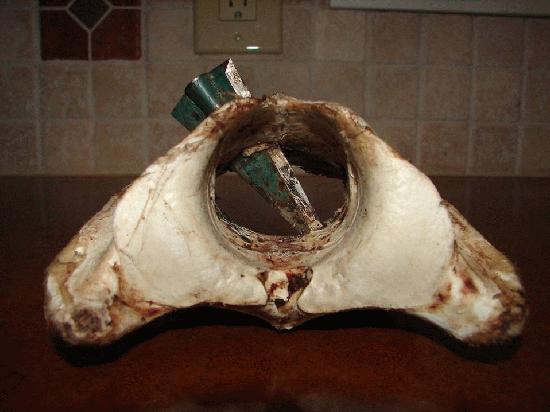
-
You can kill a lot of animals with just about any broadhead if all go’s perfect……… but what about when Murphy’s law shows up…… when the going gets tough.
Thank God you where prepared for the worst case scenario, verses the best case scenario.
-
Congrats Joe,
I used to stare at a couple spine sections that my mentor John Dodge had in his shop and dream. Oh, I never wanted to shoot a critter in the spine on purpose but I always thought how cool it would be to have a souvenir like that from a hunt. Well, my first big game animal was a barren ground caribou from along the haul road in northern Alaska. I shot that bugger in the spine and he dropped in his tracks. It was awesome! (48# John Dodge longbow with a 500 grain cedar arrow tipped with a Hunter’s Edge 3:1 head.)
Some years later, I got my first whitetail. It was on state ground in northern Indiana. She a really nice doe and, you guessed it, I got her in the spine too. (50# John Dodge longbow, 550 grain cedar arrow tipped with a 125 grain Grizzly.)
So now I have two vertebrae with broadheads stuck in them and I still think they’re awesome. They sure bring back some fantastic memories…
todd
-
I have to say thats why I shoot them even though I have not actually shot at anything with them yet 🙂 I talked to Ron at KME this past week after ordering his system and all I have to say is WOW! Hair poping sharp is no longer a measure of sharpeness but I am talking about hair PLOWING! The back of my left arm is bald…I think I am going to have to switch to a leg next! The Abowyer Brown Bears and KME system are unbeatable in my opinion. Thanks for producing such great products guys! Ron, thank you for the sharpening support and making such a wonderful piece of equipment!
-
Saturday was one of those “when things go wrong” mornings. I was hunting one of my urban properties and shot a small button buck. Top limb hit a tree branch with a loud crack on release which threw off my shot. I watched the arrow lob out there wagging back and forth then the Rothaar 4 fletch straightened it out and “thwap”, the arrow sunk right to the fletch just in front of the hind quarter as the deer turned to leave. The whole thing was like slow motion and I couldn’t believe the arrow even made it to the deer let alone sunk that deep when it hit. I was shooting a 53# JD Berry Taipan which, at my draw is about 50#. The arrow was a CX 150 with a Griz 190 out front. The little guy made it about thirty yards and fell over. The Griz cut the artery under the spine that left blood everywhere. Just one of those “rather be lucky than good” kinda mornings for sure.
-
Joe — thanks for this excellent report (and good hunting story) of your success under duress of bad luck. Did the head simply penetrate the spinem, or did it crack or split the bone in any way? We’d love to hear that important detail, with pics if possible.
Your experience, as King and others have commented, emphasizes the arrogance of saying “all that counts is a sharp broadhead and good placement.” That statement tells me the writer ain’t hunted much and is unfamiliar with Murphy’s Law, which rules the hunting universe!:P
Soon’s I get dug out of the grave of “real job” work after a month of hunting vacation, I’ll start posting similar “could be a disaster but turned out to be a winner because I used the right arrow set-up” stories from recent hunts, including my own!
While it’s gratifying to be able to say “we got it right!” when things go wrong, what we are after here is the very best truth we can sort out. So if you used a full-on Ashby setup and it failed you, please don’t hesitate to show and tell us! Good stuff, thanks, dave
-
-
AuthorPosts
- You must be logged in to reply to this topic.


